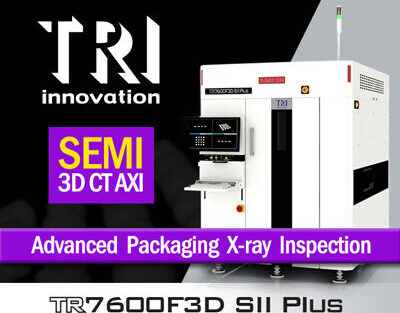The smaller, higher-density chip packages offer increased performance and reduce the size of the assembly, but introduce complications into quality assurance. Many of these ICs have hidden solder joints. Just using AOI or electrical test is no longer sufficient. X-ray inspection seems the best tool to check these locations. However, those in-line configurations are expensive and hard to program, while off-line gear is suited for samples. The alternative is the combination of vision and X-ray providing the benefits of both technologies without sacrificing throughput or time.
Claude LeBlond, Vice President of Engineering, Photon Dynamics
Inspection systems that provide both optical and X-ray inspection have become a powerful asset to electronic high-mix/ low-volume production striving to meet incessant market demands for lower cost, faster turnaround and higher quality. Unlike large-volume manufacturers, they must be able to turn their lines around quickly without sacrificing quality or throughput. The benefits of an integrated AOI/AXI system are reduced inspection and test costs, higher throughput and product quality, at a relatively low investment in equipment and operator training.
Most automated inspection systems were initially developed for large manufacturing businesses, where operating conditions are relatively controlled, stable and unlikely to require sudden changes. Early systems were too difficult to program and set-up and subject to errors when the materials and components or environment changed. Even a slight change in the lighting can make an optical system malfunction. Such conditions can often be controlled in large manufacturing operations, but are almost completely beyond the control in high-mix/low-volume environments.
The industry’s make it „smaller, faster, cheaper“ paradigm dominates every step of the electronics manufacturing process, including test and inspection. Components and board geometries continue to shrink, smaller packages appear every day, and customers demand more power in smaller footprints. Fine-pitch QFPs are common, 0402-packages are appearing in many products, and the 0201-package is now widely available. In-circuit testers (ICT) already provide as little as 40% coverage on tightly packed boards.
What you see is what you get
As populated boards get denser and geometries shrink, traditional manual visual inspections and ICT followed by functional test (FT) will be less and less effective. As many as 20 to 30% of solder joints on high complexity boards are de-coupling capacitors or parallel VCC or ground interconnections – these solder joints are not testable by electrical means. Until now, the testing burden createdby advanced devices and technologies has been assumed by AOI and AXI systems in stand-alone mode. However, while both types of inspection systems have their strengths, they also have weaknesses that are especially concerning to manufacturers who run high-mix/low-volume. AOI systems perform fast, repeatable and accurate inspections, and can find and identify defects before in-circuit or final test. They are well suited to check for component presence, component correctness and polarity, skew, solder integrity and gross solder faults. AOI systems „see“ via one or more video cameras, lights and an image-processing computer. To compensate for the relatively low resolution of video cameras, multiple cameras can be used, with indexing camera heads, and/ or indexing board fixtures, to try to inspect the entire surface of an assembly. AOI systems are used at several points in the production process, either in-line or off-line (stand-alone). In a typical surface-mount setting, inspection can be performed after part placement, reflow, or at final assembly, respectively.
Although AOI systems do an excellent job, they only can analyze features that they can see. Yet BGA, chip-scale package (CSP), flip chip and other hidden-connection devices will continue to proliferate on boards. These ICs cannot be inspected by optical systems, so manufacturers use X-ray to fill the gap. AXI systems excel at inspecting the hidden solder connections between board and BGA as well as features within most advanced semiconductor packages including die attach, wire bond and flip-chip solder bump connections.X-ray inspection is now viewed as thebest technology to identify shorts, voids, opens, misalignments and solder integrity for hidden joint defects. Its weakness is that it is difficult to program and that it cannot verify if correct components are installed, oriented correctly, and are not polarized or skewed.
The typical automated X-ray system is enclosed in a cabinet with lead-shielded walls and interlocked doors. The equipment includes a high-resolution X-ray emitter with the power to penetrate electronic devices. An image intensifier and video camera converts the image to a standard video signal. Compared with visible-light images, X-ray images are inherently noisy and low-contrast and need to be enhanced. Most companies use cabinet X-ray systems for process set-up and monitoring. Automated laminography or tomosynthesis systems are used mainly by larger operations; in higher-mix environments programming this equipment for each assembly often costs too much and takes too long.
Integrated AOI/AXI
Typically, a modern board will be composed of about 70% defect opportunities that are visible, and 30% that are hidden. Users with an eye on the bottom line have had to choose between optical or X-ray inspection because they could not afford both types of systems. They often selected an AOI system because it simply could inspect more board real estate (70% of potential defects). Integrated X-ray/vision automated systems are proving to meet the mercurial demands of high-mix/low-volume environments, making X-ray cost effective for the first time. Combining optical and X-ray allows manufacturers to inspect 100% of the assemblies with BGA, flip chip and CSP with hidden solder joints, while simultaneously inspecting for correct parts, position, orientation and other visually accessible features. In addition, integrated equipment cost less than separate AOI and AXI systems, take up less floor space, and set up in much less time.
Installing, programming and setting up intelligent AOI systems is quite straightforward. Current AOI gear can be installed and on-line in less than a day – an order of magnitude faster and easier to program than AXI systems. X-ray equipment is notoriously difficult to program. Despite this complexity, the use of X-ray continues to grow to meet the inspection requirements of complex assemblies. For high-mix/low-volume environments, X-ray systems pose a unique challenge. Time is wasted programming very complex defect rules on simple digital components that could easily be covered by the much simpler to program AOI tools.
The most time consuming process in setting up an AXI system involves programming the machine to recognize board and components. This is a three-step process. First, CAD files must be translated into a format that the system can read. Second, a board and component specific part library must be generated. Then an inspection program for each board and component is developed using the parts library and a suite of mathematical algorithms. This is the kind of difficult, hands-on work that requires a highly trained programmer to set-up the system for each board and then iterates the system over weeks or months to ensure it operates with stability. It will usually take two days to set up a typical machine for each board. The customer is confronted with either absorbing this downtime or adjusting the inspection compliance standard to be less than 100%.
With a combined AXI/AOI system, manufacturers no longer have to make trade-offs between fault coverage and programming ease. The combined gear reduces over- all programming time. Complicated X-ray programming rules only need to be applied to a specific subset of defects while the intelligent AOI capability leverages well established algorithms to inspect for the majority of defect opportunities.
Adaptive learning technology and expert systems theory are the basis for the next-generation inspection software. The learning capabilities of adaptive expert systems will reduce the need programming the vision capabilities of both systems. Instead, adaptive learning is based on a simple training-by-example approach. The inspection system gets examples of good boards, then adaptive learning technology is used to make smart decisions and find defects today’s AOI gear has not been trained to recognize. These next-generation inspection machines will be capable of distinguishing between normal process variations and genuine errors via an intelligent engine that replicates the reasoning power of a human inspector. Advanced reasoning will also allow the system to’learn‘ while in-line.
Such intelligent systems not only will detect faults with higher accuracy than conventional equipment, but they also will classify defects properly and discretely, without manual intervention, even when more than one flaw is found at a single location. Process-control loops will provide rapid feedback on common problems such as solder paste or component placement drifts, making these systems highly effective process monitoring and inspection tools. This first generation of combinational systems leverages the tremendous ease-of-use advantages of AOI and the unique vision capabilities of X-ray to provide 100% defect detection.
The SVX 2000 integrated inspection system from Photon Dynamics verifies both visible and hidden locations. It features up to three CCD video cameras, X-ray source, X-ray-sensitive camera or image intensifier, radiation shielding, and interlocks to add X-ray image processing to the optical inspection sequence. The majority of the features on board assemblies, including component presence/absence, correct/incorrect part, position, orientation and the integrity of visible solder joints, are all inspected using the color megapixel cameras, visual images and machine vision algorithms. In addition, the on-board X-ray system verifies the integrity of hidden connections.
The SVX-2000 uses the same user interface and software as the SV-7500 automated high-speed, high-resolution color AOI system. It offers high performance and can support the beat rate of virtually any production line today. Up to 12 square inches per second can be inspected. Typically, a 250-ball BGA can be verified in 1 to 2s. If desired, a rework data station is available to display a defect map. Any board that has been set up to run on SV-7500 can immediately be inspected by the SVX-2000. Typical boards set-up times are under two hours. In order to preserve the initial investment, the intelligent inspection machines are designed to be easily upgradeable and adaptable to meet the demands of next-step technology.
Zusammenfassung
Das ist die Crux der Baugruppen-Inspektion: Mit AOI können nur visuell zugängliche Bereiche kontrolliert werden, Röntgentechnik liefert zwar Bilder von verborgenen Stellen, ist aber schwierig zu programmieren. Warum also nicht beide Techniken in einem System kombinieren und dazu den Programmieraufwand durch adaptives Lernen per Expertensystem vereinfachen?
Résumé
Le point crucial en matière d’inspection des modules réside dans le fait que l’AOI ne permet de contrôler que les endroits visuellement accessibles. La technique des rayons X fournit certes des images d’endroits cachés, mais est difficile à programmer. Alors pourquoi ne pas associer les deux techniques en un même système et simplifier la programmation grâce à un apprentissage adaptatif par un système expert?
Sommario
Ecco il dilemma dell’ispezione di gruppi costruttivi: con AOI possono essere controllate solamente aree visibili, mentre la tecnica a raggi X fornisce sì immagini di aree nascoste, ma è difficile da programmare. Perché allora non combinare entrambe le tecniche in un unico sistema e semplificarne la programmazione tramite apprendimento adattivo usando un sistema esperto?
Share:










